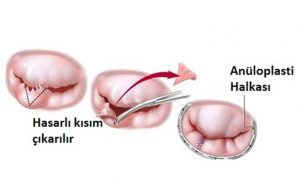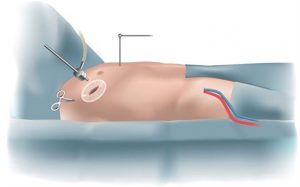Mitral valve repair is a surgical procedure to correct functional disorders of the mitral valve, which is located on the left side of the heart between the left atrium and left ventricle. Our heart has four valves, and the mitral valve is responsible for regulating blood flow on the left side of the heart. Diseases such as mitral valve regurgitation or stenosis negatively affect the heart’s blood pumping function. In this article, you can find answers to questions about what mitral valve repair is, who it is suitable for, how it is performed, and what its advantages are.
Mitral Valve and Its Structure
We can compare the mitral valve to a door. This door has a frame, hinges, and the door itself. Looking at this structure in the heart:
- Annulus: The frame surrounding the leaflets
- Leaflets: The flaps that open and close the valve
- Chordae: The tendinous cords connecting the leaflets to the heart muscle
- Papillary muscles: The muscle structure that moves the leaflets
Conditions that impair the function of these structures lead to stenosis or regurgitation problems in the mitral valve.
Treatment Options for Mitral Valve Diseases
Two methods stand out in the treatment of mitral valve diseases:
1. Mitral Valve Replacement
When the heart valve is too damaged to function properly, it is replaced. During this procedure:
- Either a mechanical valve or
- A biological valve is used.
Mechanical valves are long-lasting but require lifelong blood thinning medication.
Biological valves do not require blood thinners but risk deformation within 10-15 years.
2. Mitral Valve Repair
This is the process of correcting damaged structures without replacing the valve. The biggest advantages of this method are:
✅ Preservation of the patient’s own valve
✅ Lower risk of infection
✅ No need for long-term blood thinner use
Which Patients Are Suitable for Mitral Valve Repair?
Not every mitral valve disease is suitable for the repair method.
Particularly:
- Mitral valve stenosis: Usually results from valve calcification. The repair method is rarely preferred in this case.
- Mitral valve regurgitation: This is the condition where valve repair is most successfully applied.
Factors causing mitral valve regurgitation are evaluated with a detailed echocardiography. The structure of the leaflets, the width of the annulus region, and the condition of the chordae are analyzed to create a repair plan.
How is Mitral Valve Repair Performed?
It can be done through open-heart surgery or minimally invasive techniques. During the surgical procedure:
- The annulus (frame) is narrowed: A ring is placed in the enlarged area.
- The leaflets are repaired: If there’s excessive bulging, it is corrected.
- Chordae (cords) are added: If there’s loosening, new cords called neochords are added.
Echocardiographic checks are performed during surgery to ensure no leaks remain. If a leak is detected, the procedure is reviewed.
Advantages of Mitral Valve Repair Surgery
It has many advantages, especially for suitable patients:
- The natural valve structure is preserved.
- Lifelong blood thinner use is not necessary.
- The risk of infection is low.
- Heart function is better preserved.
- Long-term quality of life improves.
In recent years, this surgery has been successfully performed in Turkey as well. Particularly in experienced centers, repair procedures are carried out with minimally invasive and robot-assisted methods. However, it should be remembered that not every mitral valve disease is suitable for repair. Appropriate patient selection, an experienced surgical team, and technological infrastructure are critical for successful results.


